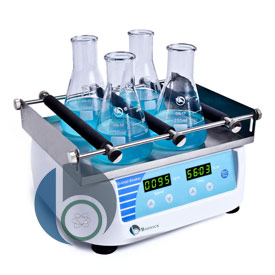Revolutionizing Laboratory Dynamics: The Universal Orbital Shaker Unveiled
In the dynamic realm of scientific research and laboratory exploration, precision is paramount. Answering this call, the Universal Orbital Shaker emerges as an indispensable and versatile ally. Engineered to deliver controlled and uniform agitation, this instrument revolutionizes mixing, shaking, and incubation across a myriad of applications. This article delves into the features, applications, and benefits of this extraordinary laboratory tool.
Features and Operation:
At its core, the Universal Orbital Shaker boasts a robust platform oscillating in a circular motion. Enhanced with adjustable speed control, scientists can tailor shaking speeds to their experiment's unique demands. The shaker's orbital movement, coupled with a meticulous temperature control system, ensures a gentle yet consistent agitation of samples.
Crafted from chemically resistant materials, the platform provides a stable surface for an array of containers—test tubes, microplates, flasks, or petri dishes. Secure placement is achieved through specialized clamps, straps, or racks designed expressly for the shaker.
Applications:
Cell Culture: Streamlining cell culture processes, the Universal Orbital Shaker fosters cell growth, suspension, and protein expression. Its subtle shaking motion facilitates uniform distribution of cells, nutrients, and oxygen throughout the culture medium.
Molecular Biology: In molecular biology experiments, the shaker proves invaluable for hybridization, staining, and washing of nucleic acid or protein membranes. It ensures meticulous reagent mixing and optimal probe-to-target interactions, elevating sensitivity and accuracy in techniques like Southern blotting or Western blotting.
Biochemistry and Chemistry: Enabling controlled agitation for enzymatic reactions, protein crystallization, or purification steps, the Universal Orbital Shaker maintains ideal conditions for reaction kinetics, protein folding, and crystallization.
Microbiology: A pivotal tool in microbiological studies, the shaker incubates bacterial cultures, promoting uniform growth and aeration. It also aids in sample extraction processes, ensuring efficient mixing and agitation for the extraction of desired compounds.
Benefits:
Versatility: Accommodating an extensive range of vessels, the Universal Orbital Shaker adapts to diverse experimental setups. It empowers scientists to process multiple samples simultaneously, optimizing workflow.
Reproducibility: Providing consistent shaking speeds and temperature control, the shaker ensures the reproducibility of experimental conditions. This minimizes variations between experiments, bolstering result reliability.
Time and Labor Savings: Automated agitation eliminates the need for manual shaking, freeing researchers' time for other tasks. It mitigates human error risks, fostering overall efficiency in the laboratory.
User-Friendly Design: Designed with user convenience in focus, the shaker features an intuitive control panel and display, simplifying parameter adjustment, progress monitoring, and real-time adjustments.
Conclusion:
The Universal Orbital Shaker stands as an indispensable force across scientific disciplines, delivering precise and controlled mixing, shaking, and incubation capabilities. Its versatility, reproducibility, and user-friendly design contribute to heightened efficiency and reliable results in laboratory experiments. Whether in cell culture, molecular biology, biochemistry, or microbiology, this versatile instrument continues to be a cornerstone in advancing scientific research and discovery."

Comments
Post a Comment